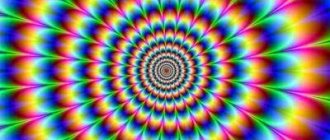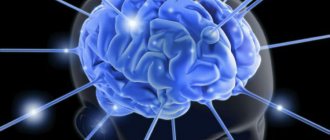Obsessive thoughts are uncontrollable urges that arise on a subconscious level. They lead to fears and anxieties, inadequate negative fantasies, and deterioration of mental health. Without proper treatment, obsessions become the cause of depressive moods, neuroses, schizophrenia, mental exhaustion, and a hermit lifestyle. The main characteristics of the disease are as follows:
- the individual does not influence the appearance of anxious and bad thoughts, they appear against his will;
- ideas that forcibly invade the mind do not arise as a result of habitual conclusions, but are isolated, alien images;
- the disease cannot be eliminated from your life with just one effort of will;
- Symptoms include severe anxiety, increased irritability;
- the patient does not lose clarity of mind and recognizes his illness.
It is precisely because of the awareness of the deplorability of his situation that the patient feels bad. He admits his deviations, but cannot fight them. All attempts to eliminate obsessive thoughts from consciousness cause even greater anxiety and fear. It is easy to convince the patient that all his incomprehensible fantasies have no proper basis. The person admits this, but the disease continues to progress. More and more new obsessions appear. Here are the most striking examples of “sticky” thoughts:
- fears about the spread and infection of diseases;
- adherence to principles in ensuring order and symmetry;
- uncontrolled obsessive counting;
- fear of force majeure, the end of the world;
- groundless and unreasoned exclusion of specific actions;
- thoughts about faith, sex, excessive aggressiveness that arise without the desire of the patient.
Obsessions lead to negative behavior and a state of increased tension. The patient himself cannot cope with his experiences, although he admits that he has a problem and that they are unfounded. It is possible to improve your condition and get rid of false ideas of reality only by receiving competent medical care.
Treatment of obsessive thoughts
The Salvation Clinic treats obsessive thoughts using progressive techniques and proven pharmacotherapy. Our staff includes highly qualified psychologists and psychotherapists who have experience and the opportunity to travel to various international conferences. The clinic provides decent conditions for keeping patients, nutritious food, and leisure. The patients do not need anything. It is possible to install an individual nursing station and rent a VIP room. The clinic has specialized security. No one will be able to enter or leave unnoticed. We strive to alleviate the condition of our patients and bring recovery closer. Contacting our center will improve the patient’s quality of life and provide the opportunity for a full-fledged existence.
Patients are treated individually. The program is developed on the basis of long-term observations of the patient’s behavior, his state of health, tests, taking into account age. The greatest effect of treatment is achieved with a combination of psychotherapy and drug therapy. Medicines (tranquilizers, antidepressants and antipsychotics) allow you to:
- correct neurotic symptoms;
- remove anxiety and fears;
- control mood and behavior.
Psychotherapy is an integral part of treating obsessive thoughts. Through individual counseling you can:
- understand the nature of the occurrence of deviations;
- eliminate the cause that led to the disease;
- eliminate fears and anxieties;
- develop stress resistance and self-confidence;
- eliminate depressive moods;
- teach how to manage symptoms;
- help a person socialize.
In their practice, our center’s specialists use the following approaches:
- Cognitive behavioral therapy. Based on the theory of behaviorism and the cognitive approach. The latter implies that deviations in mental development are provoked by illogical thinking and incorrect beliefs of the individual, by eliminating which it will be possible to get rid of obsessive thoughts and anxieties. Adherents of behaviorism recognize that the main influence on the mental development of an individual and his behavior is exerted by genetic predisposition, but they also attach important importance to environmental factors. By eliminating support for undesirable behaviors and encouraging desirable ones, a person's habits and lifestyle can be changed.
- Hypno-suggestive techniques. Verbal and non-verbal influence is made on the consciousness of the individual in order to introduce the necessary attitudes and programs. During the session, control is removed, attention is reduced, and the opportunity to program consciousness opens up. As a result of hypnosis treatment, motivation to action, changes in state and behavior are produced. The suggestive instructions given by the doctor penetrate deeply into the patient’s subconscious, which ensures positive dynamics of treatment. When using hypno-suggestive methods, depression, neurosis, phobias, alcoholism, smoking, drug addiction are successfully treated, and obsessions are eliminated.
- Autotraining. Allows you to restore the function of self-regulation impaired due to stress. The method is based on the use of self-hypnosis, self-education, and muscle relaxation. The advantage of auto-training is the involvement of the patient in the treatment process. There are two stages of training: higher and lower. At the initial stage, relaxation exercises, training of the cardiovascular system, and training in the principles of proper breathing are performed. As a result of treatment, the patient’s general well-being, blood supply to the brain and internal organs improves, the heartbeat normalizes, and headaches are relieved. At the highest stage, training is carried out to induce certain complex experiences by introducing the patient into trance states of varying depth and intensity.
We guarantee the correct diagnosis and improvement of the patient’s condition. The treatment regimen for obsessive thoughts is developed collectively. We focus on the complete elimination of symptoms and a return to an independent active life without worries and restrictions.
What types of obsessions exist and how do they manifest themselves?
Differentiation of obsessions (obsessions) is of practical importance for diagnosis and choice of treatment. Read more about Gestalt therapy. In modern psychiatry, the following types of obsessions are distinguished: • Obsessive doubts - constant uncertainty about committing or not committing certain actions. For example, whether the door is locked or not, whether the iron or gas is turned off, the form may have been filled out incorrectly or the details on business documents have been mixed up, the instructions from the authorities have been carried out correctly or not, etc. It is characteristic that repeated checks do not lead to getting rid of doubts, but only give rise to increasing uncertainty in oneself and one’s actions. • Intrusive memories of sad, unpleasant or shameful events associated with feelings of shame and remorse. They literally dominate the patient and interfere with an adequate response to current events. • Obsessive urges that encourage you to commit dangerous, cruel, and sometimes sadistic acts. This is the most destructive type of obsessions that cause the patient fear and horror from the failure of attempts to get rid of them. An example could be the desire to throw yourself or push a loved one under the wheels of a moving vehicle, physically abuse your wife, or kill your own child. The fear of carrying out such actions can be classified as one of the most painful phobias. • Obsessive ideas constitute a fairly diverse group of obsessions and concern either a figurative vision of the results of one’s own or someone else’s cruel behavior, or the perception of implausible, sometimes absurd situations as if they actually happened. For example, a patient may be convinced that his loved one was buried alive, imagines all the suffering of a person buried alive and is tormented by this. As the disease progresses, a person ceases to distinguish between reality and fiction, and is finally convinced of the correctness of his ideas, which translates obsession into the category of extremely valuable delusional ideas. • Obsessive antipathy towards certain people - relatives, respected persons, clergy and even saints. This irrational antipathy is associated with cynical, blasphemous thoughts towards them, sometimes even inciting violent actions. • Obsessive phobias, expressed in an inexplicable fear of heights, crowds, open or enclosed spaces, sudden death, incurable disease, etc. Very rarely, phobias multiply like mushrooms after rain and acquire the character of panphobia, when a person is afraid of everything. In addition, such a paradoxical effect as the emergence of an obsessive fear of developing fears (phobophobia) is possible. Obsessions are also differentiated into such types as: • Obsessions of neutral content, which include obsessive counting, memories of terms, insignificant situations, obsessive thoughts on neutral topics, etc. • Contrasting, otherwise aggressive obsessions, which manifest themselves in the fear of harming oneself or loved ones, in blasphemous thoughts and/or sadistic ideas. Such obsessions are completely alien to the patient’s consciousness, are not motivated and are accompanied by strong affective manifestations. • Obsessions with contamination and/or contamination (mysophobia). This group includes a variety of obsessive fears of contamination by dust, soil, excrement, toxic substances, and pathogens. The latter has become especially relevant today in the era of the coronavirus pandemic. In addition, people are afraid of small objects, such as glass shards or needles, entering the body. Preventive measures on the part of the patient often do not usually attract others, especially when frequent washing and wearing masks become justified and necessary in an epidemic. But when they acquire hypertrophied and irrational forms, it is no longer possible to explain them by excessive cleanliness or disgust. When a patient, under normal living conditions, without a real threat of infection, continues to observe the maximum security regime, does not leave the room and does not even allow loved ones near him, this already threatens complete desocialization and is not justified by the force of habit. Here you need the help of a specialist. The list of the most common obsessions includes isolated monophobias in the form of movement disorders, most often originating from childhood. These can be such familiar phenomena as: • smoothing imaginary falling hair, which actually lies perfectly in the hairstyle; • getting rid of an imaginary speck in the eye by blinking; • habitual tics; • head movements simulating throwing off an invisible headdress; • biting and licking lips; • spitting, etc.
All these mono-disorders can be corrected and treated quite successfully, and also rarely progress.
Obsessive thoughts and fears
Obsessions bring significant discomfort to the patient’s life. He cannot get rid of the desire to succumb to them, to correct the situation. What causes compulsions? This is a syndrome that occurs at certain intervals as a result of compulsive behavior. In its absence, the patient experiences a feeling of anxiety. Resistance to urges ceases when a person can no longer resist the obsessions. The most common “rituals” in this case:
- cleansing (a person is obsessed with the idea of bringing perfect cleanliness to the house, this also includes frequent washing of hands and body);
- satiety (the patient has an excessive appetite amid concern about controlling his body weight);
- ensuring security (a person constantly checks whether the door is locked, whether all electrical or gas appliances are turned off;
- observance of rationality (the patient zealously adheres to the regime, places objects in a certain order, steps over cracks in the asphalt);
- bookkeeping (the patient involuntarily monitors the number of things around him).
A person’s behavior during forcibly invading fantasies may look quite ordinary and does not arouse suspicion. However, a person is unable to renounce performing compulsive “rituals” due to anxiety that something terrible might happen. He is simply forced to carry out the actions to which his anxious thoughts are pushing him. Unfortunately, after the ritual, the person does not feel relief. And the fear of trouble pushes him to even more fanatical execution of actions imposed by alien thoughts. With this behavior, obsessive-compulsive disorder develops. The disease progresses mainly between the ages of 10 and 30 years. People with a high level of intelligence are most susceptible to the disease. In addition to this disease associated with obsessions, there are others.
Phobia
Translated from Greek, this term means “unhealthy fear.” It arises as a result of certain actions, situations, objects, people, animals. A person is panicky afraid of an irritant that causes fear. In some cases, phobias cause an inappropriate reaction, leading to aggression. Deviation can occur as a result of severe stress, overwork, nervous tension, or mental disorder. To date, a large number of phobias have been identified. The most common among them are:
- fear of open/enclosed spaces or crowded places;
- fear of swimming;
- fear of blood;
- fear of specific animals, insects;
- fear of loneliness;
- fear of touching money.
Phobias are often accompanied by panic attacks. A person imagines a quick end, as a result of which he may experience:
- numbness of hands and feet;
- labored breathing;
- discomfort in the heart area;
- diarrhea;
- dizziness.
All this affects the patient’s quality of life and requires immediate medical intervention. Treatment for a phobia depends on its type. In this case, he uses the principle of “knocking out a wedge with a wedge.” The patient is allowed to face his fear. However, this technique is associated with a strong emotional shock and does not always pay off.
Neurasthenia
The disease is characterized by excessive irritability, rapid fatigue, and loss of ability for prolonged mental and physical work. Pathology can be triggered by psychological trauma, nervous tension at work, chronic lack of sleep, lack of proper rest, chronic intoxication, infectious diseases, unhealthy diet, and endocrine disorders. The disease is accompanied by:
- frequent headaches;
- disruptions in the functioning of the cardiovascular system;
- disturbance of sleep and wakefulness;
- diarrhea/constipation.
The most favorable prognosis for treating neurasthenia at the initial stage. A change of environment, work, streamlining of the daily routine, and proper rest can help. In advanced cases, hospitalization in a specialized hospital and the prescription of pharmacotherapy, including restorative drugs, antidepressants and tranquilizers, may be required. With proper treatment, complete recovery can be achieved.
Schizophrenia
Schizophrenia is a difficult to diagnose complex mental disorder associated with inadequacy, unpredictability of behavior, insanity, illogical thinking, and detachment from society. The disease is most common in people aged 14 to 35 years. Symptoms include:
- delusional ideas;
- depressive moods;
- decreased mental and motor activity;
- deterioration in concentration;
- persecution mania;
- auditory hallucinations;
- bouts of hysteria or crying for no reason;
- delusions of grandeur;
- slurred speech;
- sloppy appearance.
The disease can be triggered by severe stress, mental stress, and heredity. Although there have been cases of sudden onset of schizophrenia with complete mental comfort.
To make an accurate diagnosis, it is necessary to observe the patient’s behavior for a long time (at least 6 months), communicate with the patient’s relatives, general and biochemical blood tests, a clinical study of the immune status, hormonal profile, magnetic resonance therapy to exclude brain diseases that may cause tumors, abscesses, and viral encephalitis.
What is OCD and how common is it?
Obsessive-compulsive disorder (OCD) is a mental illness that combines a group of obsessive-compulsive syndromes (symptom complexes) associated with obsessive thoughts and actions, which get their name from the Latin words obsessio (blockade, siege) and compulsio (coercion). To put it simply, obsessions are obsessive illogical thoughts, and compulsions are irrational actions imposed by them, which together are interpreted as an obsessive state. In fact, OCD is an obsessive disorder (OS), which is confirmed by the reduction in the ICD (International Classification of Diseases) of almost all types of obsessive disorders to the category of obsessive-compulsive disorder. Compulsions are obsessive, irresistible desires that are uncontrollable by a person, developing against his will and reason, causing negative emotions and often incompatible with his moral and ethical principles. Patients are aware of the wrongness and irrationality of their actions, but cannot resist them. The uncontrollability of compulsions by consciousness leads to feelings of fear, anxiety and the development of depression. In a broader context, compulsions are a wide variety of obsessive physical actions, often acquiring a ritual nature. Obsessive-compulsive disorder is characterized by multiple repetitions of psychopathological phenomena in the patient’s mind, accompanied by a feeling of involuntariness, compulsion, awareness of their irrationality and at the same time the failure of attempts to resist them. All these phenomena have a negative impact on the general emotional background, often causing depressive moods and reducing performance. At the same time, the patient has a critical attitude towards obsessive states. As for questions about the impact of OCD on intelligence, the answers in this case are ambiguous. Some authors believe that the obsessive state does not reduce the intellectual potential of the patient, others note cognitive impairment related to spatial and verbal memory, verbal fluency, and speed of information processing. NS is also differentiated depending on its location in the mental-emotional (phobia) and/or motor sphere (compulsion). These types of NS are practically never found on their own; in the human mind they are usually present in combination with each other, and in different proportions. If obsessive thoughts are difficult for others to notice, then compulsive actions are obvious and it is impossible to hide them from those close to you. In addition, NS can be divided into the following conditions: • Caused by specific and obvious psychogenic causes. • Having no apparent cause, so-called cryptogenic NS. OCD can occur as an independent mental disorder or in combination with sluggish schizophrenia, depression, epilepsy, after traumatic brain injury and in some somatic diseases. According to statistics, OCD affects 1 to 3% of the population, with the average age of hospitalized patients being 31.6 years, although the disease usually begins in adolescence and young adulthood (10-25 years). This indicates that a significant period of time passes between the onset of the disease and a visit to a specialist, on average about 7.5 years. At the same time, the majority of patients who consult a doctor for the first time are no longer able to study or work, and only a quarter of them can fully perform these functions.
Causes of obsessive thoughts
It is difficult to establish exactly the nature of the occurrence of alien anxious thoughts. This is most associated with the underlying disease. May also affect:
- heredity;
- hormonal imbalance, due to which there is a dysfunction of the brain;
- psychological trauma;
- severe stress;
- sensitive temperament;
- pregnancy;
- disability;
- the presence of protracted infectious diseases.
A qualified psychiatrist can determine the causes of obsessive thoughts. Required:
- personal consultation;
- conducting experiments to see the overall clinical picture;
- interviewing the patient's relatives;
- observing his behavior;
- use of a neurophysiological test system and neurotest;
- carrying out laboratory tests.
Treatment of obsessions is carried out in conjunction with the underlying disease. Depending on the patient’s condition, it can be performed in a hospital or in an outpatient setting.
What is the differential diagnosis of OCD?
Differential diagnosis makes it possible to distinguish OCD from a number of other mental disorders, which are also characterized by obsessions and ritualistic actions. OCD in the case of obsessive thoughts of perverted content, as well as eccentric, increasingly complex and expanding rituals must be differentiated from sluggish schizophrenia. The presence of prolonged obsessive states must be distinguished from paroxysmal schizophrenia. The possibility of schizophrenia may be indicated by sharply increasing anxiety, the inclusion of new objects in the sphere of obsessive associations, when objects, situations or accidentally spoken words that were previously indifferent to the patient remind him of phobias and take on a threatening meaning. Sometimes it is necessary to differentiate OCD with habitual tics from Gilles de la Tourette syndrome with generalization of tics, when the latter are localized in the face, neck, limbs and are expressed by grimacing, protruding the tongue, sharp and strong gestures. In addition, it is necessary to differentiate between OCD and depressive disorder. This is due to the fact that they often accompany each other. In the acute phase, the disorder whose symptoms predominate is usually diagnosed. When the process becomes chronic, a diagnosis is made of the disorder whose symptoms persist when the symptoms of another disappear.
ICD-10 notes that the differential diagnosis between obsessive-compulsive disorder and depressive disorder (F32, F33) can be difficult because the two types of symptoms often occur together. In an acute episode, preference is given to the disorder whose symptoms occurred first. When both are present but neither is dominant, it is recommended to assume that the depression was primary. For chronic disorders, it is recommended to give preference to the disorder whose symptoms persist most often in the absence of symptoms of the other.
How to get rid of obsessive thoughts in your head
Obsessions are a real reason to visit a doctor. Only with the help of a specialist will it be possible to eliminate inappropriate ideas. You should not try to find a way to improve your well-being on your own. Self-medication can lead to worsening of the condition, progression of the disease, dependence on drugs and alcohol, in which the patient seeks solace. However, they only aggravate the situation, as they can cause delusions and hallucinations.
Heart-to-heart conversations help with obsessions. Relatives and people with similar problems will understand better. It may be advisable to sign up for group psychotherapy. However, even the closest people are not always ready to listen. Optimally, contact a good psychiatrist. In addition, you must:
- understand your desires;
- do not forget about self-control;
- adhere to the treatment regimen;
- learn more about your condition;
- accept the problem;
- realize the need for treatment;
- get enough sleep;
- adhere to the rules of good nutrition;
- give up alcohol and other psychoactive substances;
- lead an active lifestyle;
- avoid nervous fatigue and anxiety;
- be distracted by relaxing with family and friends, building a career;
- there is no need to allow obsession to interfere with a full existence.
Our clinic specialists are ready to listen to you right now. We provide on-site consultations and guarantee complete confidentiality. Highly qualified doctors will be able to correctly diagnose and offer an effective solution to eliminate the problem.
Obsessive states
(From the book PSYCHIATRY, edited by R. Scheider. Translation from English: Moscow, “Practice”, 1998)
I. General information. Obsessive states (also called anancastic reactions) are widespread. As a temporary phenomenon, they are observed in most healthy adolescents and adults. Psychasthenic psychopathy is also common - a condition in which the tendency to obsessively repeat thoughts and actions is a character trait. In addition, 2-3% of adults suffer from obsessive-compulsive disorder.
II. Types of obsessions
A. Obsessive thoughts (obsessions) are the incessant repetition of unwanted, often painful thoughts, ideas and desires that cannot be gotten rid of by force of will. There is always a feeling of their violence. The patient understands that obsessive thoughts originate within himself (unlike a patient with schizophrenia, who is sure that someone is controlling his thoughts). The content of obsessive thoughts is unacceptable or meaningless to the patient, so he tries to fight them. This is the fundamental difference between obsessions and overvalued ideas and delusions, observed, for example, in depression: firstly, overvalued and delusional ideas are not accompanied by a feeling of violence, and secondly, there is no criticism of them, the patient does not resist, but, on the contrary, defends his thoughts . Sometimes obsessive thoughts at first are not violent and alien to the patient: excerpts of songs, individual words, or, for example, thoughts of a young man about intimacy with a woman he likes, who may not know that she is the object of desire. Over time, such thoughts may disappear, but they can actually become obsessive and persistent. Typically, obsessive thoughts concern the following interrelated areas of life: 1) morality and religion; 2) aggression; 3) pollution, infection; 4) health and illness; 5) accuracy, striving for symmetry; 6) sexual sphere (especially shameful actions). It can be seen that in all cases, harm to oneself or others is directly or indirectly implied. The topic of pollution or contamination comes up much more often than others. Other common examples: an obsessive desire to return home and check if the door is locked; obsessive urge to say obscenity in public.
Let us emphasize once again that obsessive thoughts are fundamentally different from overvalued ideas. With obsessive states, the patient is rarely completely focused on any one thought; in addition, intrusive thoughts are always perceived as violent. Therefore, it is obvious that the basis of, for example, anorexia nervosa is precisely an overvalued idea that does not cause resistance from the patient (however, this overvalued idea is often incorrectly considered an obsessive desire to lose weight). It is interesting, however, that in the character of young women suffering from anorexia nervosa, signs of obsessions are often found - excessive diligence in study, physical exercise, etc. The same can be said about transsexuality: although some authors believe that transsexuality is this obsessive feeling of being a woman trapped in a man’s body (and vice versa), in fact, it is rather a constant perverted perception of one’s body (as in body dysmorphomania).
B. Obsessive actions are stereotypical, repetitive, seemingly aimless actions, which often have the appearance of a ritual. There are four main types of such actions: 1) cleansing (most often washing hands and wiping surrounding objects); 2) verification; 3) actions related to clothing: dressing in a special sequence, endlessly straightening clothes; 4) counting (often in the form of listing objects and out loud). A funny children's counting rhyme (“king, prince, king, prince…”) can become a real torment for a patient with obsessive counting. Obsessive counting in some cases is an obsessive thought (counting to oneself), in others it is an obsessive action (counting out loud, for example, in time with breathing). In an obsessive action there is a subjective component - attraction, or compulsion, and an objective component - ritual (real actions caused by attraction, which can be both noticeable and invisible to others, for example, counting in time with breathing). Rituals are always associated with an internal feeling of incompleteness of any actions: “It is better to redo it than to leave it unfinished.” So, the doctor can re-read the test results many times, call the pharmacy back several times to check whether the prescription was written correctly. In adolescence and young adulthood, especially among girls, there is often an obsessive desire to touch the face or straighten the hair (a combination of checking and cleansing).
B. Pathogenesis and differential diagnosis. Mild forms of obsessions obviously have adaptive significance. They distract attention from other, perhaps more unpleasant thoughts and experiences (by type of displacement). Children's games-rituals have a similar connotation - for example, not to step on cracks in the asphalt. Rituals can be a way to suppress anger and control yourself. At the current level of knowledge about the pathogenesis of obsessive states, we cannot exclude that ritual is an exaggerated protective behavior. Perhaps our Self subconsciously senses some subtle defect (neurological or otherwise) and initiates actions (such as checking) that supposedly reduce the negative consequences of such a defect. But if control over these actions is impaired (for example, perseveration with lesions of the frontal lobes), then they become repetitive and obsessive.
Obsessive states are sometimes very difficult. Incessant obsessive thoughts and actions bring the patient so much suffering that their protective role, if any, is lost. The automatic, involuntary nature of the compulsions at times resembles tics. The author has observed many patients with obsessive-compulsive states of varying severity and is convinced that only mild forms of them can be classified as actually “neurotic” and they should be distinguished from real obsessive-compulsive neurosis. There seems to be no smooth transition between mild obsessions and obsessive-compulsive neurosis, and one of the proofs of this is given below - in patients with obsessive-compulsive neurosis, a history of psychasthenic psychopathy is detected quite rarely.
Obsessive thoughts and actions have many similarities with obsessive fears - phobias, but they differ in many ways. All these conditions limit the freedom of the patient, but he is always aware that painful thoughts, ritual actions and unjustified fears originate in himself and are devoid of any meaning. However, the patient cannot suppress them on his own, and attempts to get rid of them only increase anxiety. Severe anxiety may occur at the beginning of a course of behavioral psychotherapy, but if the disease has not gone too far, then it gradually decreases.
Unlike obsessive thoughts and actions, with simple phobias (obsessive fears associated with specific objects or situations), the patient does not experience obvious anxiety or discomfort unless faced with a frightening object. Therefore, simple phobias usually do not cause everyday anxiety, since traumatic situations can be avoided. For simple phobias, as a rule, mental desensitization in combination with mental relaxation is effective.
With social phobia, it is not so easy to overcome anxiety, since it always arises in the presence of other people (the patient is afraid that everyone will watch him, judge him, that he will be constantly embarrassed or will do some funny and ridiculous things). But even in this case, subjective experiences and decreased ability to work are rarely as pronounced as with obsessive-compulsive neurosis.
III. Psychasthenic (anancastic) psychopathy (in ICD-10 and DSM-IV - obsessive-compulsive personality disorder). As already mentioned, transient obsessions are common in both children and adults. The diagnosis of psychasthenic psychopathy is made if these traits are a character trait. People suffering from psychasthenic psychopathy have a pathological passion for perfection, and this makes their existence difficult: any action must be so perfect that it cannot be completed. At first, this character trait can be expressed moderately, does not affect social adaptation, and is often even liked by parents and teachers, but later it becomes more and more unbearable.
Individuals with psychasthenic psychopathy are also characterized by straightforwardness, inflexibility, stubbornness, frugality, excessive conscientiousness, and indecisiveness. Such people devote almost all their time to work, paying a lot of attention to minor details, are prone to hoarding and have difficulty parting with any little thing, their concept of morality is exaggerated almost to the point of fanaticism. As a result, sometimes the behavior as a whole changes: the person seems sticky and inhibited. More often, however, psychopathy occurs in a milder form. In this case, the behavior from the outside looks normal; such people are punctual, reliable, conscientious, save money, always finish what they start, their mood seems even from the outside - all these qualities are certainly positive and increase self-esteem. “To my friend, punctuality was not just a character trait, but a way of life...” (Tom Stoppard on Bertrand Russell; Jumpers, New York: Groove Press, 1972, p. 25).
The symptoms of psychasthenic psychopathy change over time, and decompensation due to stressful situations is typical for it. However, it usually does not develop into obsessive-compulsive neurosis: although it was previously believed that 50% of patients with this neurosis have psychasthenic psychopathy, according to modern data, this figure does not exceed 5-10%. With decompensation of psychasthenic psychopathy, as a rule, one or another affective disorder develops, and not obsessive-compulsive neurosis.
IV. Obsessive-compulsive disorder (in ICD-10 and DSM-IV - obsessive-compulsive disorder)
A. General information. Obsessive-compulsive neurosis is a disorder in which obsessions literally haunt a person and poison his entire existence - communication, work, rest. Attempts to deal with obsessions are usually unsuccessful, and this further increases anxiety.
The etiology of obsessive-compulsive disorder is unknown. The role of genetic factors cannot be ruled out. Among identical twins, there is a high concordance for this disease, while fraternal twins are more often discordant. The prevalence of obsessive-compulsive disorder neurosis in parents of patients is 5-7%, and among the general population - 2-3%. Obsessions are typical for boys with Gilles de la Tourette syndrome: 25-35% of male patients suffering from this disease meet the criteria for obsessive-compulsive neurosis. It is not yet clear whether this combination is genetic; Perhaps there is a common gene that causes Gilles de la Tourette syndrome in boys, and obsessive-compulsive disorder in girls.
The average age of onset of obsessive-compulsive disorder is 20 years. Often there is a sudden onset in adolescence, without previous symptoms. A third of the cases are children (under 15 years of age); Their average age is 7-10 years, the minimum is 3 years. Boys get sick on average earlier than girls. Occasionally, obsessive-compulsive disorder begins after 40 years of age (less than 10% of cases). The onset of the disease is often preceded by stress (pregnancy and childbirth, death of a family member, sexual failure), but in 70% of cases the provoking factor cannot be identified. Trichotillomania (obsessive hair pulling) usually begins in adolescence or young adulthood; Women are more likely to get sick.
The course of obsessive-compulsive neurosis is chronic, wave-like, even if the onset was acute. Spontaneous improvements (remissions for more than a year) are observed in less than 10% of cases. In mild forms of obsession, little annoyance occurs to the patient; in severe forms, complete loss of ability to work is possible. Many people hide their illness: obsessive thoughts seem so stupid, terrible and indecent to the patient, and rituals so pretentious that he is afraid of being disgraced if someone finds out about them.
B. Treatment. The main methods are medication and behavioral psychotherapy. It is extremely rare, in very severe forms of the disease and ineffectiveness of conservative treatment, to resort to psychosurgery.
1. Drug treatment. The use of serotonergic drugs for obsessive-compulsive disorder has not only clinical, but also some pathogenetic justifications. Firstly, the level of 5-hydroxyindoleacetic acid, a product of serotonin metabolism, is increased in the CSF of patients. Secondly, the serotonin antagonist metergoline causes exacerbation in treated patients and worsens the course of the disease in untreated patients.
The duration of drug use has not been established. If only drug treatment is carried out, then after its cessation a relapse usually occurs. Drug treatment (in the absence of side effects) should apparently be continued until the effect of psychotherapy appears. After this, the drug is gradually withdrawn.
Combining psychotherapy with serotonergic drugs often produces better results than either method alone. Some patients, however, refuse psychotherapy, and sometimes it is not feasible for other reasons. In these cases, medications are prescribed for an indefinite period. In this case, constant monitoring is necessary in order to promptly identify the delayed toxic effect of drugs due to their accumulation.
2. Behavioral psychotherapy for obsessive-compulsive neurosis is based on a combination of provoking obsession and preventing ritual. Provoking a compulsion reduces the distress caused by the compulsion, while ritual avoidance reduces the time spent performing the ritual. For example, consider the following case: our patient is afraid that if he lifts the toilet seat before urinating, he will definitely contract AIDS (even at home). However, being a well-mannered person, he still raises the seat every time before urinating. He can calm the anxiety that has arisen only by washing his hands for 5 minutes. The patient hates this ritual because it takes time and is noticeable to others. When obsessiveness is provoked, the patient is asked to specifically lift the toilet seat with his hands (in this case, one should not grasp the seat with toilet paper or lift it with the toe of a shoe); thereby, as it were, “increasing” the risk of contracting AIDS (in fact, it is impossible to become infected this way). The patient’s anxiety increases, and at this moment they give a new task: reduce the hand washing time to 4 minutes. Behavioral therapy, of course, should be accompanied by psychological support and a detailed story about AIDS in order to ease the patient's anxiety and increase the mood for recovery. When repeating tasks, both the anxiety associated with touching the toilet and the time required to complete the ritual gradually decrease. The patient begins to understand that he can cope with his painful feelings even without ritual.
25% of patients refuse behavioral therapy: it causes them too much anxiety. Among those who completed the course, in half of the patients the severity of obsessions and the ritual time are reduced by 70% or more, in another 40% of patients - by 30-69%. In 60% of patients receiving behavioral therapy, symptoms, as a rule, remain stable for 6 years or more, and if they increase, then at a moderate pace. If only drug treatment is carried out, then almost always a relapse occurs quickly after its completion.
Mental relaxation, which is often considered a method of actively inhibiting anxiety, is actually a passive component of behavior therapy. It can have an indirect effect, serving as a protective mechanism that patients resort to when painful sensations arise. However, some patients, on the contrary, prefer rapid and complete provocative therapy without trying to reduce anxiety - the so-called immersion method. The intensity of anxiety, however, does not affect the outcome of treatment.
Traditionally, psychoanalysis, other non-behavioral methods of psychotherapy, and hypnosis are used in the treatment of obsessive-compulsive neurosis. However, when used independently, their effectiveness is low. They can be resorted to only if the main methods of treatment (drug and behavioral therapy) are unsuccessful. All patients need psychological support: an explanation of the nature of the disease, sympathy, and the creation of a mood for recovery.
Literature
1. Barr, L. C., Goodman, W. K., et al. The serotonin disorder hypothesis of obsessive-compulsive: Implications of pharmacological challenge studies. J. Clin. Psychiatry 53(4[Suppl]):17-28, 1992.
2. Benkelfat, C., Murphy, D. L., et al. Clomipramine in obsessive-compulsive disorder: Further evidence for a serotonergic mechanism of action. Arch. Gen. Psychiatry 46:23-28, 1989.
3. Chouinard, G., Goodman, W. K., et al. Results of a double-blind placebo controlled trial of a new serotonin uptake inhibitor, sertraline, in the treatment of obsessive-compulsive disorder. Psychopharmacol. Bull. 26:279-284, 1990.
4. Dominguez, RA, Jacobson, AF, et al. Drug response assessed by the modified Maudsley obsessive-compulsive inventory. Psychopharmacol. Bull. 25:215-218, 1989.
5. Flament, M. F., Rapoport, J. L., et al. Clomipramine treatment of childhood obsessive-compulsive disorder: a double-blind controlled study. Arch. Gen. Psychiatry 42:977-983, 1985.
6. Fontaine, F., Chouinard, G. An open trial of fluoxetine in the treatment of obsessive-compulsive disorder. J. Clin. Psychopharmacol. 6:98-101, 1986.
7. Goodman, W. K., Price, L. H., et al. Efficacy of fluvoxamine in obsessive-compulsive disorder. A double-blind comparison with placebo. Arch. Gen. Psychiatry 46:36-44, 1989.
8. Goodman, W. K., Price, L. H., et al. The Yale-Brown obsessive-compulsive scale. 1. Development, use, and reliability. Arch. Gen. Psychiatry 46:1006-1011, 1989.
9. Greist, J. H. Treatment of obsessive-compulsive disorder: Psychotherapies, drugs, and other somatic treatments. J. Clin. Psychiatry 51(8 [Suppl]):44-50, 1990.
10. Hollander, E., Mullen, L., DeCaria, C. M. Obsessive-compulsive disorder, depression, and fluoxetine. J. Clin. Psychiatry 52:418-422, 1991.
11. Hewlett, A., Vinogradov, S., Agras, WS Clonazepam treatment of obsessions and compulsions. J. Clin. Psychiatry 51:158-161, 1990.
12. Hewlett, W.A., Vinogradov, S., Agras, W.S. Clomipramine, clonazepam, and clonidine treatment of obsessive-compulsive disorder. J. Clin. Psychopharmacol. 12:420-430, 1992.
13. Jenike, M. A., Baer, L., et al. Sertraline in obsessive-compulsive disorder: A double-blind comparison with placebo. Am. J Psychiatry 147:923-928, 1990.
14. Jenike, M. A., Buttolph, L., et al. Open trial of fluoxetine in obsessive-compulsive disorder. Am. J Psychiatry 146:909-911, 1989.
15. Jenike, M. A., Hyman, S., et al. A controlled trial of fluvoxamine in obsessive-compulsive disorder: Implications for a serotonergic theory. Am. J Psychiatry 147:1209-1215, 1990.
16. Karno, M., Golding, J. M., et al. The epidemiology of obsessive-compulsive disorder in five US communities. Arch. Gen. Psychiatry 45:1094–1099, 1988.
17. Leonard, H. L., Swedo, S. E., et al. Treatment of obsessive-compulsive disorder with clomipramine and desipramine in children and adolescents. A double-blind crossover comparison. Arch. Gen. Psychiatry 46:1088–1092, 1989.
18. Levine, R., Hoffman, J. S., et al. Long-term fluoxetine treatment of a large number of obsessive-compulsive patients. J. Clin. Psychopharmacol. 9:281-283, 1989.
19. Liebowitz, M.R., Hollander, E., et al. Fluoxetine treatment of obsessive-compulsive disorder: An open clinical trial. J. Clin. Psychopharmacol. 9:281-283, 1989.
20. Murphy, DL, Pigott, TA Obsessive-compulsive disorder: Treatment with serotonin-selective uptake inhibitors, azapirones, and other agents. J. Clin. Psychopharmacol. 10 (Suppl):91S-100S, 1990.
21. Perse, T. L., Greist, J. H., et al. Fluvoxamine treatment of obsessive-compulsive disorder. Am. J Psychiatry 144:1543–1548, 1987.
22. Rasmussen, SA, Eisen, JL Epidemiology of obsessive-compulsive disorder. J. Clin. Psychiatry 51:10-13, 1990.
23. The Clomipramine Collaborative Study Group. Clomipramine in the treatment of patients with obsessive-compulsive disorder. Arch. Gen. Psychiatry 48:730–738, 1991.
24. Turner, S. M., Jacob, R. G., et al. Fluoxetine treatment of obsessive-compulsive disorder. J. Clin. Psychopharmacol. 5:207-212, 1985.
25. Volavka, J., Neziroglu, F., et al. Clomipramine and imipramine in obsessive-compulsive disorder. Psychiatry Res. 14:85-93, 1984.
26. Zohar, J., Insel, TR, et al. Serotonergic responsivity in obsessive-compulsive disorder: Effects of chronic clomipramine treatment. Arch. Gen. Psychiatry 45:167–172, 1988.
VSD and obsessive thoughts
Against the background of symptoms of vegetative-vascular dystonia, obsessions can arise out of the blue. The person panics and feels helpless. “Sticky” thoughts are primarily associated with deteriorating health. The patient may be bothered by sharp pain in a specific organ, which quickly passes. There is rapid fatigue, apathy, a feeling of lack of air, heaviness in the heart area. All fears associated with fear for health come down to thanatophobia. This is the fear of death. Because of this, the nervous system is in constant tension, the situation gets worse. A sick imagination can also paint pictures of the death of loved ones. When you are forbidden not to think about such things, a person plunges even more into the abyss of his phobia. Presents a variety of colorful variations. Relatives must take the patient’s complaints seriously, otherwise the gap between them will only grow.
Compulsive behavior may include:
- Check: A person may get up several times a night to make sure the iron is turned off. May also reread each email or text a dozen times to check for typos.
- Cleaning: People with OCD can wash their hands until the skin cracks. They can also disinfect household items after each use (instead of following the instructions in the owner's manual).
- Repositioning/Repetition: A person may press a light switch a certain number of times or straighten clothing until it is perfectly straight.
- Withdrawal: A person may repeat the same phrase to “cleanse” themselves of sexual thoughts or unpleasant images.
When a person's obsessive feelings are not obvious to observers, they are said to have pure obsessive OCD (also called pure OCD). For example, a person may silently count to 100 after completing certain tasks to ensure that they end with a “safe” thought. Another, for example, may mentally recite strings of words to make sure he doesn't lose his memory. Compulsions can interfere with a person's functioning, even if they are not visible to others.
Depression with obsessive thoughts
The disorder can lead to depression. A person is constantly in a depressed mood and loses the ability to rejoice. There are other symptoms of the disease:
- low self-esteem;
- loss of interest in life;
- impaired concentration;
- obsessive feelings of guilt;
- bad attitude;
- disturbance of sleep and wakefulness;
- refusal to eat;
- thoughts of suicide;
- tendency to use alcohol and drugs;
Depression is one of the more common mental disorders. Recent advances in the field of pharmacotherapy and psychiatry make it possible to achieve complete recovery in 96.7% of cases.
Captured by obsessions
Such people pay too much attention to their thoughts, constantly rummaging through them, analyzing, scanning, trying to identify something suspicious in anticipation of obsessive thoughts. This phenomenon is called “consciousness monitoring.”
People with obsessive reasoning literally break them into pieces in order to analyze them, talk about their essence, think about what could lead to these kinds of ideas, and what they threaten.
For example, a woman is terrorized by the obsessive conviction that she is possessed by the devil. Understanding the absurdity of what is happening, she, nevertheless, is unable to get rid of this thought. The patient thinks that, most likely, this is a punishment for her for some sins, and if she does not get rid of this thought, she will go crazy.
There is a fear that a person may lose control over obsessive reasoning and give free rein to emotions. As a rule, these are negative emotional reactions: anger, aggression, rage. They can lead to tragic consequences, harm someone, cause damage.
Patients are tormented by reasoning that their thoughts are abnormal. The question and judgment arise: “Where did they come from, why is this happening to me? I'm crazy. This doesn't happen to anyone else. I shouldn't think like that. This is bad and disgusting."
The individual believes that everything should be exactly the way he wants. Unwanted thoughts will destroy everything. Therefore, he must be on guard not to allow obsessions to arise freely in his head.
If pathological reasoning does appear, then the person believes that it is he who is to blame. He needs to take strict control of the situation in order to prevent obsessions from winning and to prevent something terrible from happening.
When obsessions return again and again, the confidence is born that the patient is gradually losing control, and with it, reason.
A conviction emerges: you can’t leave everything as it is. The existence of absurd reasoning cannot be tolerated; it must be neutralized. Many begin to avoid situations that can provoke obsessive syndrome. A woman possessed by the devil may avoid watching films on similar topics, refuse to attend church, or, on the contrary, begin to pray intensely.
Thinking and acting this way is fundamentally wrong. This will in no way alleviate the patient’s condition, but will prepare fertile ground for uninvited thoughts.
Obsessive thoughts in neurosis
Such a diagnosis can be made when a person has been tormented for a long time by “sticky” thoughts and urges to realize them, feelings of fear and anxiety. Obsessive ideas and actions are observed to be hyperbolic and unrealistic. All this leads to suffering and other mental disorders, including alcohol and drug addiction.
The “obsessed” person constantly thinks that he can become infected with an incurable disease or get dirty. A sick imagination pushes him to perform certain daily rituals. In their absence, a person is sure that something bad will happen. Over time, the situation only gets worse. Rituals are performed with greater intensity and fanaticism. A person cannot leave the house until he has checked several times whether all electrical and gas appliances are turned off and whether all the windows are closed. With obsessive-thought neurosis, other phobias may also arise. For example, fear of one’s death and loved ones, fear of spiders and snakes, fear of the dark, fear of betrayal by a sexual partner.
At first, a person does not give in to much panic at the provocations of fantasies that forcibly invade the consciousness. Then be ashamed of your behavior and attitude towards life. Some patients simply do not know where they can get help. It may take 7-10 years from the time the disease develops until you see a doctor.
You should not delay contacting a specialist if something is bothering you or your relative and preventing you from concentrating on a normal life. Sometimes you just need to talk it out. Seeing a psychologist is a normal practice in the West. Perhaps there is no significant problem. It’s better to play it safe and find out the opinion of a specialist than to drive yourself into the abyss of your fears, depressive moods, or be led by inappropriate thoughts. Contact us, we can listen to you right now and help you cope with stress and anxiety!
What are the symptoms of OCD and what is characteristic of its clinical picture?
According to ICD-10, the basic signs of OCD are regularly recurring intrusive thoughts (obsessions) and compulsive actions in the form of peculiar rituals.
The clinical course is dominated by thoughts and memories associated with fear and anxiety. They are painful for the patient, alien to his thinking, and arise involuntarily, as if “from within.” The patient can fight them only by performing stereotypical ritual actions that relieve nervous tension and eliminate anxiety. After performing the ritual, the patient receives calm and relief for a while. But it does not last long - until the next occurrence of obsessive thoughts. By the way, to make a diagnosis of OCD, the duration and frequency of occurrence of obsessive states are important. If it takes more than 1 hour a day to perform ritual actions in total for 1-2 weeks or more, then we can talk about the presence of obsessive-compulsive disorder.
As I already said, the initial stage of development of OCD usually occurs in adolescence and young adulthood (10-25 years). Moreover, it is during this period that the most pronounced clinical picture of the disease is observed, the main manifestations of which are the following symptoms: 1. The presence of obsessions - fleetingly arising painful thoughts, ideas and images that forcibly invade a person’s thinking, which he is trying to resist. This confrontation between the occurrence of obsessions and attempts to fight them can cause deep internal conflict in the human psyche. The form of obsessions can be very diverse - individual words, phrases, poems, song verses, images, scenes, etc. Moreover, they can be quite shocking, lustful, obscene and disgusting. 2. The emergence of obsessive stimuli - urges to commit certain actions, including dangerous, shameful and even sadistic. For example, running across the road in front of moving traffic, undressing in a public place, shouting obscenities, or even hitting a child.
3. Performing obsessive rituals, of which there can be two options: • Mental in the form of mental repetition of a count or certain words. In this case, counting is often combined with words. For example, say the words “nothing will happen” or “everything will be fine” 6 times, and repeat this procedure three times. And also end with a verse of some unknown reason chosen song or poetic lines. The ritual is quite complex and demanding, because at the slightest failure it must be repeated, otherwise, in the opinion of the patient, it will lose its effectiveness. • Physical actions that are sometimes striking in their absurdity. For example, if washing your hands too often can be explained by the fear of infection, then looking in the mirror a certain number of times before leaving the house has no logical basis. Over time, rituals can become more complex and become a problem in everyday life and at work. 4. Internal obsessive discussions regarding the arguments for and against certain actions. Obsessive doubts can concern even the most simple situations, for example, turning off household appliances, locking locks, fear of hitting someone while driving, remorse due to non-compliance with religious requirements, or the use of obscene language. 5. Perfectionism - the desire for order and symmetry, when everything should be perfectly ordered and located in its place. 6. Compulsions – regular repetition of actions that are protective and preventive in nature in relation to even the most unlikely situations that are potentially dangerous for the patient himself and his family. Often patients in this case avoid the circumstances and places with which their fears are associated. For example, kitchens where knives are located or workshops with piercing and cutting tools. It is difficult to imagine the torment of a housewife who is afraid to be in her own kitchen or a professional seamstress who is afraid of scissors and needles. 7. Superstition, exaggerated attention to everything that may be associated with good or bad luck.
8. Obsessive fears (phobias) up to panic attacks. All these psychopathological phenomena are accompanied by varying degrees of anxiety, which all obsessive and compulsive rituals are aimed at reducing. To assess the severity and dynamics of the clinical picture of OCD, the so-called Yale-Brown scale is used. It consists of 10 points that the patient must answer during a conversation with the doctor. Answers are scored on a five-point scale from 0 to 4 and cover a one-week period. The sum of the obtained indicators allows us to differentiate the severity of OCD symptoms, for example, a sum of up to 7 points indicates a subclinical course, and 32-40 points indicate an extremely severe course of OCD. Comparison of weekly indicators allows us to evaluate the effectiveness of treatment and the course of the disease over time. It should be noted that adapted versions of the Yale-Brown scale have been developed for the patient’s self-assessment of his mental state.
Let go of fears and physical tension
Let's repeat: accept your obsessive fears, and then make a conscious choice to put your fear aside or change the way you think about it. Once you've done either of the two, your next task is to let go of those fears and get back to your daily activities. If you're like most people, you become physically tense and anxious when you try to stop these thoughts, so you need to relieve that tension.
There are two steps towards this goal. First, decide to stop the intrusive thoughts or images, and reinforce this decision by repeating positive affirmations to yourself. Give yourself mental support by telling yourself things like: “Thinking about this won't help me right now; now is not the time to think about it; this is irrational and not logical, I need to give it up; I’m not going to argue with that idea.” If possible, say this out loud to yourself and help yourself to believe yourself. Do not repeat phrases unless you yourself believe that they are true.
Before using these techniques, make sure you are truly committed to getting rid of your fears. Make this decision at a time when you are not experiencing obsessive fear, when you are calm and can look at things soberly. Make sure it's a firm decision. Then choose a phrase that reflects your position on the issue. For example, you might decide that the next time you start worrying, you'll start writing down—word for word—every thought that comes into your head until you start repeating yourself. Then you say to yourself, “These fears are irrational, and I know it. I'm ready to overcome them."
The second step, after you have clearly expressed your decision to give up fear, is to practice breathing relaxation. There are many very simple breathing exercises that can help reduce your stress, and many manuals and resources describe them.
How to deal with obsessive thoughts generated by a real problem
If you are worried about the prospect of failing exams or a presentation, then, unlike a global flood or the end of the world, these are much more likely events. And, again, unlike the end of the world and the global flood, you can influence them. Nobody denies the element of chance in the form of ordinary luck or bad luck, however, by preparing properly for the event, you will reduce the influence of chance to a minimum.
What to do:
- Look at what you can really influence - prepare theses on each issue in advance, practice the oral block of the speech, something else.
- Look at where you really didn’t work - you don’t have enough information to fill out the presentation, you didn’t understand some topic on the subject you were taking, you have problems with skills and preparing public speaking.
- Work on weak points - make sure that you clearly speak the text of the presentation or answers to topics out loud and do not miss key facts and details.
- Think about what the worst-case scenario could be in case of failure - dismissal from work, change of profession, military service and expulsion from the university.
- Prepare as best you can for the worst-case scenario - update your resume, review job listings, schedule refresher courses.
If you are still worried about an event that happened in the past (a disastrous presentation, a harsh conversation with your boss), think about what conclusions should be drawn from this and what actions to take. It is better to put your conclusions and, in general, everything that worries you in writing - this way, willy-nilly, you will be forced to clearly formulate what worries you and what are the options for the development of events.
After you formulate the essence of the concern, conclusions, options for events and possible actions for each case, and work out all the weak points, you can safely drive your bad obsessive thoughts away. How to drive? And approximately the same as you need to drive away obsessive thoughts and emotions.
Look, squirrel! (take a break)
The joke about how a person can be distracted by a squirrel outside the window that has nothing to do with business seems to be funny, but there is only a grain of joke in it. Anxiety distracts us from important matters and steals our attention. You can change the focus by putting several squirrels together.
Anxiety takes your attention and doesn’t let go. The thoughts in our head have no relation to reality, but they manage to seem real. We are able to resist anxiety by focusing on reality. When we are overwhelmed by anxiety, we can shift our focus and become distracted.
An effective tool, if necessary, to regain control of attention is awareness. You probably remember from previous exercises how to bring yourself back to the present moment and escape from the clutches of anxiety by using all your senses. Paradoxically, when you improve your attention, mindfulness can be your biggest distraction.
The idea is to focus on something other than your worry. Think about change, not suffering. Sometimes squirrels outside the window are just what you need to loosen the grip of anxiety. And the actions that you take to turn on awareness are the “proteins” that distract you from heavy thoughts day or night.
- Make yourself a shimmering ball. Fill the jar about halfway with hot water, squeeze out more glitter glue and stir. You can add more sparkles and some small objects. Then fill the jar with water, leaving room for items to float when you shake the jar. The process itself is a distraction, and now you have a jar that you can shake at any time of the day or night to distract yourself.
- Carry a distracting item with you. It's often very helpful to distract yourself with something tangible. Put a hair tie, a rubber bracelet, or just some kind of rubber band on your wrist. When you catch yourself thinking about your worries again, gently click it or just remember it in your hands.
- Listen to music or soothing sounds of nature. Distracting your hearing is also useful. These are the “squirrels” that you hear rather than see, and they are great for relieving anxiety.
By using distractions, over time you will train your mind to do so naturally and before anxiety takes over your attention.
What you can do now: carry in your pocket, bag, wallet something that will always be at hand and can distract you: an elastic band, bracelet or cord, or basically anything - for example, a photo of a pet.









